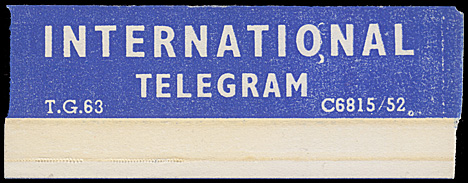Labels - International Telegram.
- Home, index, site details
- Australia 1901-1988
-
New South Wales
- Overview of NSW
- Telegraph lines
- Telegraph Offices
- Date stamps
- Forms
- Envelopes
- Instructional annotation
- Collect
- Delayed
- Free
- Immediate Urgent
- Reply paid
- Rates
- Stamps
- 1871 Telegraph stamps
- 1885 proposal
- 1893 proposal
- Queensland
- South Australia
- Tasmania
- Victoria
- Western Australia
- International
- Special aspects
| Heading and notes: | Form No. T.G. 63. INTERNATIONAL TELEGRAM in one or two lines. |
| Reverse side: | Blank. |
| Colours (text & form): | Black on orange paper or Orange on white or blue on white - reverse printed. |
| Size of form overall: | Varied. |
- blue and white labels are just white in
lower 10 cm.
On occasions, labels were used inappropriately (although understandably) - for example an URGENT label on an International or radiogram telegram. A reminder about appropriate use appeared in the Post Office Monthly Circular for December 1952:
19. Attachment of "International Telegram" Adhesive Dockets (TG 63) to "Radio telegrams": Instances have been noticed where urgent adhesive dockets (T.G. 54) have been attached to radiotelegrams. The appropriate docket is an "International Telegram" docket "T.G. 63).
In order to avoid misunderstanding, arrangements are being made to amend paragraph 2110 of Postmasters' Instructions as follows: " ...International telegrams (including radiotelegrams to or from ships at sea) must be received on the appropriate Commonwealth telegram forms (ordinary or urgent) and a docket (Form T.G. 63) bearing the words "International Telegram" must be affixed to the top portion of the form by the receiving officer ...". A serial amendment for the above-mentioned alteration will be issued in due course. (N. 321/1/3).
.jpg) Delivery form AB-DO-8Cb printed in February 1933. Message entirely in five character code. |
AB-LI-1.
London, UK to Adelaide via Beam (Chief Telegraph Office of Characteristics of label:
Also recorded in use in:
|
 Form printed in November 1938. |
AW-LI-2A.
Abroad (origin not specified) to Edgecliff, NSW. Used on delivery form Characteristics of label:
|
 Form printed July1943. |
AW-LI-2B.
Berkeley, Calif to Queensland Same size and arrangement of lettering in two lines as for the previous label (AW-LI-2A) but:
See a label of this type used at Tamworth with a special date stamp of 26 November 1942. |
 Form printed in September 1940. |
AW-LI-3.
Overseas to Langhorne's Creek via Imperial Used on delivery form Characteristics of label:
|
 |
AW-LI-3.
Shows position of form number. |
 label.jpg) Form printed in July 1942. |
AW-LI-4.
Tunbridge Wells to Launceston 26 July 1945. Used on delivery form Characteristics of label:
Few of these orange labels were printed and it is probable they were only used at selected Post Offices. Certainly the rarest of all the labels. Also known used on 23 April 1949 at Moreland, Vic on |
 Form printed in July 1943. |
AW-LI-5.
Buffalo, New York to Brisbane (C.T.O. Brisbane of 9 January 1945). Used on a delivery form Characteristics of label:
|
 Form printed in July 1947. |
AW-LI-6A.
Singapore to Rockdale, NSW Via Imperial (Telegraph Office of 11 July 1949). Used on delivery form Characteristics of label:
|
 |
AW-LI-6A showing position of form number. |
 Form printed in August 1951. |
AW-LI-6B.
Wellington, NZ to St. Kilda, Vic Used on delivery form Characteristics of label:
|
 |
AW-LI-6B showing position of form number and schedule number. |
 |
AA-LI-6C.
Singapore to West Perth, WA (Rectangular CHIEF TELEGRAPH OFFICE 11 February 1957 - ERD). Characteristics of label:
|
 |
AW-LI-6C showing position of form number and schedule number. |
Details of use and rarity.
| Form sub-number |
Label number. | Schedule number | Earliest recorded date | Rarity rating |
| LI-1 | None. | 25 April 1934 at Telegraph Branch Adelaide. | RR | |
| LI-2A | None. | 23 October 1941 at Edgecliff, NSW. | RR | |
| LI-2B | None. | 26 November 1942 at Tamworth. | RRR | |
| LI-3 | None | 5 November 1942 at Langhorne's Creek, SA. | RRR | |
| LI-4 | T.G. 63 | None. | 5 October 1944 at CTO Brisbane Qld. | RRRR |
| LI-5 | T. G. 63 | None. | 9 January 1945 at C.T.O. Brisbane. | RRR |
| LI-6A | T.G. 63 | None. | 11 July 1949 at Rockdale, NSW. | R |
| LI-6B | T.G. 63 | C6815/52 | 15 June 1954 at St. Kilda TO. | R |
| LI-6C | T.G. C.7567 | Sch. 6968 | 24 September 1957 at T.O. Burnie, Tas. | R |
| Sch. C. 7567 | 12 February 1957 at Chief Telegraph Office, Perth, WA. | RR |
not for unused, unattached examples (which are common).